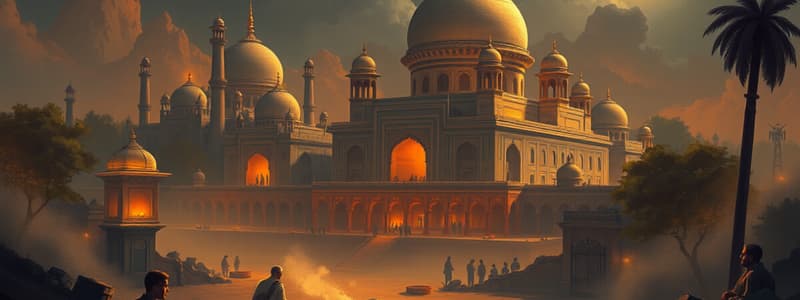Podcast
Questions and Answers
Which of the following business houses progressed during the Nehru era?
Which of the following business houses progressed during the Nehru era?
- Mafatlals (correct)
- Bajaj’s
- Tata’s (correct)
- Ambani’s
What was the significant pronouncement made by the Nehru government in 1948?
What was the significant pronouncement made by the Nehru government in 1948?
Industrial Policy Resolution
The Indian Constitution guaranteed the right to vote to every adult instantly establishing a democracy.
The Indian Constitution guaranteed the right to vote to every adult instantly establishing a democracy.
True (A)
Who founded the Swatantra Party?
Who founded the Swatantra Party?
The model of socialism in India was referred to as the ____.
The model of socialism in India was referred to as the ____.
What was nationalized in 1969?
What was nationalized in 1969?
Match the following Industrial Policy Resolutions with their contents:
Match the following Industrial Policy Resolutions with their contents:
What year was the Life Insurance business nationalized?
What year was the Life Insurance business nationalized?
Flashcards are hidden until you start studying
Study Notes
Post-Independence - The Nehru Era
- Jawaharlal Nehru became the Prime Minister of India after independence, focusing on economic development.
- Existing business houses that flourished included Tata (TISCO, TELCO, Tata Chem), Birla, Thapar, Kirloskar, Mafatlals, Lalbhais, and Walchand.
- New business entities emerged: Bajaj, Mahindra, Godrej, Singhania, Bangur, Goenka, Kalyani, Khaitan, Ruia, Chowgule, Salgaonkar, Dempo, and Dhirubhai Ambani.
Economic Policies and Mixed Economy
- The Industrial Policy Resolution of 1948 emphasized increased state involvement in economic activities while allowing private capital to flourish.
- The government reserved exclusive rights to establish new enterprises in basic industries, promoting a mixed economy model.
- Establishment of the Planning Commission aimed at systematic economic planning to synchronize private and public sector activities.
Nationalization and Licensing System
- Key sectors such as banks, airlines, and insurance companies were nationalized, marking extensive state control over economic resources.
- Introduction of the industrial licensing system illustrated the regulatory environment termed "License Raj."
Political Framework
- The Indian Constitution established universal adult franchise, making India the first democracy to guarantee this right from its inception.
- Personal freedoms including movement, assembly, and expression were constitutionally protected.
- Although a socialist framework was considered, it was ultimately rejected in favor of a dynamic economic system capable of evolving with public needs.
Socialism and Economic Control
- India adopted a moderate approach to socialism, implementing central planning while maintaining some degree of private property and economic freedom.
- Rajaji coined "Quota-Permit-License Raj" in the late 1950s to describe India's unique economic model.
Development of the License Raj
- Industrial Policy Resolution, 1948: Established government monopoly in key industries (armaments, railroads, minerals, etc.).
- Industrial Policy Resolution, 1956: Expanded government control over an additional 12 industries, building on the prior resolution.
- Nationalization milestones: Life Insurance in 1956 and large commercial banks in 1969.
- Monopolies and Restrictive Trade Practices Act, 1970: Monitored firms with assets exceeding Rs 200 million to curb private power concentration and regulate business practices.
- Continued state intervention in the insurance sector and broader economic landscape through various policies and regulations.
Studying That Suits You
Use AI to generate personalized quizzes and flashcards to suit your learning preferences.




